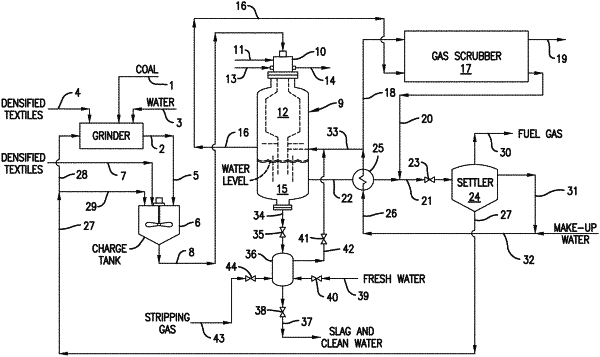| CPC C08B 17/02 (2013.01) [B09B 3/40 (2022.01); C10J 2300/0903 (2013.01); C10J 2300/093 (2013.01); C10J 2300/0946 (2013.01); C10J 2300/1656 (2013.01); C10J 2300/169 (2013.01); D01F 2/24 (2013.01); D01F 13/00 (2013.01); D10B 2201/28 (2013.01); D10B 2401/12 (2013.01); Y02E 50/30 (2013.01); Y02P 20/143 (2015.11); Y02P 70/62 (2015.11)] | 14 Claims |

|
1. A process of making a densified textile derived polymer reactant comprising:
making a densified textile derived syngas by gasifying a feedstock slurry composition comprising solid fossil fuels and densified textile aggregate;
reacting said densified textile derived syngas to make the densified textile derived polymer reactant,
wherein the densified textile aggregate has a particle size of not more than 2 mm, and the solid fossil fuel in the feedstock composition has a particle size of less than 2 mm, the solids content in the slurry is at least 62 wt. %, the amount of densified textile aggregate present in the feedstock stream slurry composition is 0.1 wt. % to less than 20 wt. % based on the weight of all solids, and the water is at least 20 wt. % based on the weight of the feedstock slurry composition, and
the slurry is stable as determined by having an initial viscosity of 100,000 cP or less at 5 minutes, or 10 minutes, or 15 minutes, or 20 minutes, or 25 minutes, or 30 minutes using a Brookfield R/S Rheometer equipped with V80-40 vane operating at a shear rate of 1.83/s or a Brookfield viscometer with an LV-2 spindle rotating at a rate of 0.5 rpm, measured at ambient conditions; and/or
the slurry is pumpable as determined by having a viscosity of less than 30,000 cP, or 25,000 cP or less, or not more than 23,000 cP, or not more than 20,000 cP, or not more than 18,000 cP, or not more than 15,000 cP, or not more than 13,000 cP, after mixing to obtain a homogeneous distribution of solids throughout the slurry and using a Brookfield R/S Rheometer equipped with V80-40 vane operating at a shear rate of 1.83/s or a Brookfield viscometer with an LV-2 spindle rotating at a rate of 0.5 rpm, measured at ambient conditions.
|